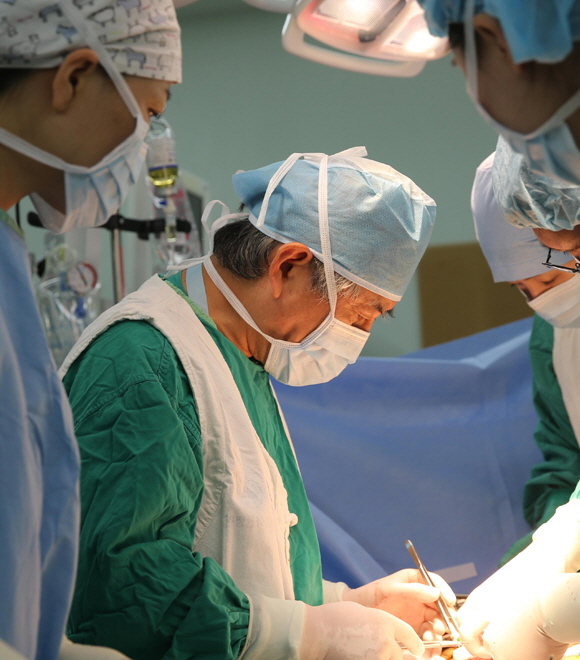

Why should you receive
organ transplantation in AMC?
Organ transplantation is an operation that replaces the affected organ of a terminally ill patient with a healthy organ of a brain-dead or a living person. Transplantation is performed on a patient who cannot be treated with conventional therapies due to intractable diseases. Transplantation of organs including the solid organs such as the kidney, liver, pancreas, heart, and lungs as well as the tissues such as the cornea, bone marrow, bones, blood vessels, cartilage, amnions, fasciae, and heart valves are possible. After the first successful kidney transplantation in 1969, transplantation of the kidney, cornea, and bone marrow has been performed. Thereafter, the first deceased donor liver transplantation (DDLT) in 1988 was succeeded by the pancreatic and heart transplantations in 1992 and the lung transplantation in 1996.
AMC’s Liver Transplantation Center laid the foundation stone for DDLTs in Korea and paved the way for raising awareness for brain dead organ donation and transplantation. In May 1992, the center began with the first deceased donor multi-organ transplantation. The center had received global attention as it was the first to perform living donor liver transplantation using a modified right lobe graft in 1999, a dual living donor liver transplantation in 2000, and exchange liver transplantation in 2003. Furthermore, a steady stream of overseas medical professionals from prestigious transplantation centers around the world has been visiting AMC for training.
AMC’s Liver Transplantation Center, with disregard to the number of surgeries, has strengthened its outstanding position in treatment outcomes and survival rates for each type of organ transplantation; all the meanwhile, strengthening its efforts in continuous research and experiments and advanced training programs. The center will strive to concentrate on treatment, research, and training to achieve increased survival rates and better treatment outcomes.
Treatment Method

Kidney transplantation
The kidneys perform essential functions, including filtering waste products from the blood. As kidney disease progresses, kidney function declines, eventually leading to end-stage kidney disease (ESKD). Patients with ESKD require kidney replacement therapy, such as hemodialysis, peritoneal dialysis, or kidney transplantation.
Kidney transplantation has been performed since the 1950s. In South Korea, the procedure was first introduced in 1969 and was adopted by AMC in the 1990s. Since then, the number of kidney transplantations at AMC has steadily increased. In 1996, AMC recorded the highest number of kidney transplantations in South Korea. By January 2012, AMC had reached a total of 3,000 cases and became the first center in South Korea to exceed 300 kidney transplantations per year. As of January 2023, AMC has successfully performed approximately 1,000 ABO-incompatible kidney transplantations, reflecting its continued advancement in the field.
Kidney donors may be living donors, including family members, spouses, relatives, or unrelated volunteers, or they may be brain-dead donors. Since the human body has two kidneys, donating one is generally safe, and donors can live a normal life after the surgery. Suitable donors must be in good health and free from conditions such as uncontrolled hypertension, diabetes, kidney disease, major infections, or cancer.
For transplantation, donor and recipient compatibility must be confirmed, particularly through human leukocyte antigen (HLA) crossmatching. Even if blood types are incompatible, advances in immunosuppressive therapies and desensitization protocols have made ABO-incompatible kidney transplantation possible. AMC has continuously and successfully performed these procedures since 2009.
-
Donor
Kidney donation may be from a living donor (immediate family member, spouse, relative, and voluntary donor) or a brain dead donor. Because the human body originally has two kidneys, donating one of them is considered safe. Donors may lead a normal life after the surgery. Kidney donation is possible in donors who are in good health and do not have hypertension, diabetes, renal disease, major bacterial infections, cancer etc. Also, kidney donors and recipients must have and build, while not showing adverse reactions from the HLA cross matching test. Even if the blood type is incompatible, new drugs and therapies available today allow for kidney transplantation (ABO incompatible) surgeries. Since 2009, AMC has continuously performed them successfully.
-
Transplant procedure
Living Donor Kidney Transplantation
- Initial evaluations for both donor and recipient are conducted by the Department of General Surgery, the Division of Nephrology, or the Division of Pediatric Nephrology.
- If eligible, both donor and recipient are admitted for comprehensive pre-transplant testing.
- If no contraindications are found, transplantation is scheduled and performed.
- Postoperative care and monitoring begin immediately after surgery.
Post-Transplant Care
Following transplantation, patients typically remain hospitalized for about two weeks. After discharge, they continue with regular outpatient follow-ups. To prevent rejection of the transplanted kidney, patients must take immunosuppressant medications daily for as long as the transplanted kidney remains functional.
Treatment performance

AMC’s Liver Transplantation Center laid the foundation stone for DDLTs in Korea and paved the way for raising awareness for brain dead organ donation and transplantation. In May 1992, the center completed the first deceased donor multi-organ transplantation. In July 1992, the Center succeeded Korea’s first simultaneous pancreas-kidney transplantation. Then in August 1992, it completed the first liver transplantation and then the first heart transplantation in November. Ultimately, it took a lead in the field of deceased donor organ transplantation.
Moreover, the center performed Korea’s first living donor partial liver transplantation in 1994, the first simultaneous liver-kidney transplantation in 1999, the first adult-to-adult split-liver transplantation in 2003, the first simultaneous heart-kidney transplantation in 2005, and the first living donor simultaneous kidney-pancreas partial transplantation in 2006. It also performed the first simultaneous liver-heart transplantation in 2007, the first simultaneous seven-organ multi visceral transplantation in 2011, the first simultaneous liver-lung transplantation in 2012, and the first simultaneous liver-heart-lung transplantation in 2015. Such performance has contributed greatly to enhancing Korea’s overall medical skills and expertise in organ transplantation. Not only that but also, the center had received global attention as it was the first to perform living donor liver transplantation using a modified right lobe graft in 1999, a dual living donor liver transplantation in 2000, and exchange liver transplantation in 2003.
Thanks to recent corneal transplantation, bone marrow transplantation, and tissue transplantation, many patients have been given new hope. Every transplantation team at the center makes continuous efforts in attaining remarkable achievements. Through their efforts, achievements such as 9,000 liver transplantations by April 2025, 7,000 kidney transplantations by December 2022, 900 heart transplantations by August 2023, and 500 pancreas transplantations by October 2022 were made possible.
